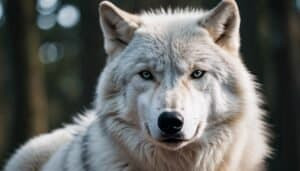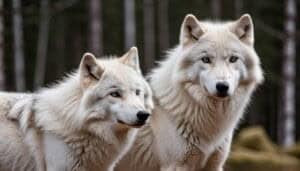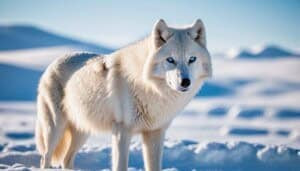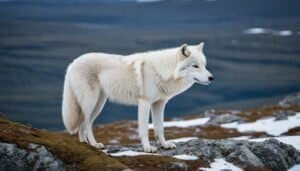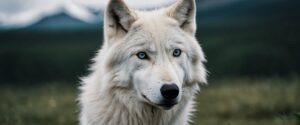Introduction
The olfactory bulb of the Arctic wolf is a critical component of its sensory system, playing a vital role in its ability to survive and thrive in the harsh Arctic environment. This article will explore the location and structure of the olfactory bulb, its mechanisms for processing scents, and its impact on hunting behavior and social interactions
Additionally, we will examine the unique adaptations of the olfactory bulb to the Arctic environment, its development in wolf pups, and comparisons with other wolf species. Finally, we will discuss the overall importance of the olfactory bulb in the Arctic wolf’s navigation and survival
The Arctic Wolf’s Olfactory Bulb
The olfactory bulb in the Arctic wolf is a sophisticated structure essential for processing scents, which are crucial for the wolf’s survival. It plays a key role in detecting prey, recognizing pack members, and navigating their environment
This section delves into the specifics of the olfactory bulb’s location, structure, and its critical functions
Location and Structure
The olfactory bulb is located at the front of the Arctic wolf’s brain, directly above the nasal cavity. It is part of the limbic system, which is involved in emotions and survival instincts
The olfactory bulb has a unique layered structure, with each layer playing a specific role in the scent processing pathway:
Glomerular Layer: The outermost layer where sensory neurons from the nasal cavity converge. This is the first point of contact for odor molecules
External Plexiform Layer: Contains interneurons that help modulate signals before they reach deeper layers
Mitral Cell Layer: Mitral cells receive processed signals and relay them to the brain’s olfactory cortex
Granule Cell Layer: Contains granule cells that provide feedback inhibition to fine-tune the scent signals
The olfactory bulb’s structure allows it to efficiently process complex scent information, enabling the Arctic wolf to detect subtle changes in its environment
Scent Processing Mechanisms
The olfactory bulb processes scents through a series of well-coordinated steps:
Odor Detection: Odor molecules enter the nasal cavity and bind to receptors on the sensory neurons
Signal Transmission: Sensory neurons transmit electrical signals to the glomeruli in the olfactory bulb
Signal Integration: In the glomeruli, signals from similar receptors are integrated and refined
Relay to Mitral Cells: The processed signals are then relayed to the mitral cells, which send the information to the olfactory cortex in the brain
Interpretation: The brain interprets these signals as specific scents, which can trigger appropriate behavioral responses
This mechanism allows the Arctic wolf to detect prey, recognize other wolves, and avoid predators
Role in Hunting Behavior
The olfactory bulb is crucial for the Arctic wolf’s hunting behavior. Its highly developed sense of smell helps in several ways:
Tracking Prey: Wolves can follow scent trails left by prey, even in harsh Arctic conditions
Detecting Hidden Prey: The ability to detect faint scents enables wolves to find prey buried under snow
Coordinated Hunting: Wolves communicate with each other through scent marks, coordinating their movements during hunts
This enhanced olfactory capability is essential for successful hunting, especially in the resource-scarce Arctic environment
Contribution to Social Interactions
Social interactions among Arctic wolves are heavily influenced by their sense of smell, facilitated by the olfactory bulb:
Identifying Pack Members: Each wolf has a unique scent, allowing them to recognize and bond with pack members
Territorial Marking: Wolves mark their territory with scent, which is recognized by other pack members and intruders
Reproductive Behavior: Scent signals play a role in mating, helping wolves identify when potential mates are in estrus
These social behaviors are critical for maintaining pack cohesion and ensuring the survival of the species
Environmental Adaptations
The olfactory bulb of the Arctic wolf has several adaptations for its harsh environment:
Enhanced Sensitivity: Adaptations in the olfactory receptors allow detection of faint scents over long distances
Temperature Resilience: The olfactory bulb functions effectively despite extreme cold, ensuring reliable scent detection year-round
These adaptations are vital for the Arctic wolf’s ability to thrive in one of the most challenging environments on Earth
Development in Pups
In Arctic wolf pups, the olfactory bulb undergoes significant development after birth:
Early Growth: The olfactory bulb grows rapidly in the first few weeks, enabling pups to recognize their mother and siblings
Learning to Hunt: As pups mature, their olfactory skills are honed through play and imitation of adult wolves
This developmental process is crucial for preparing young wolves for independent survival
Comparison with Other Wolf Species
While all wolves have a keen sense of smell, the Arctic wolf’s olfactory bulb has some unique features:
Greater Sensitivity: Adaptations specific to the Arctic environment make the Arctic wolf’s sense of smell more acute than other species
Specialized Receptors: Differences in olfactory receptor types reflect the unique dietary and environmental needs of the Arctic wolf
Importance of Olfactory Bulb in Survival
The olfactory bulb is not only a key player in the Arctic wolf’s sense of smell but also a crucial element for its overall survival. This section explores how the olfactory bulb impacts navigation, and the general significance of the sense of smell for the Arctic wolf’s survival in the harsh Arctic environment
Impact on Navigation
The Arctic wolf’s ability to navigate its vast and often desolate environment is heavily reliant on its olfactory bulb:
Scent Trails: Wolves use scent trails left by other animals to find food and navigate through their territory. These trails can lead them to prey, water sources, and safe resting places
Landmark Identification: By marking and recognizing scents, wolves can identify landmarks and maintain a mental map of their territory. This is especially important in the Arctic, where visual cues can be scarce due to snow cover
Avoiding Dangers: The olfactory bulb helps wolves detect the presence of predators or rival packs through scent, allowing them to avoid potential threats and navigate safely
The olfactory bulb’s role in navigation underscores its importance in ensuring the Arctic wolf can efficiently move through and survive in its challenging habitat
Overall Survival Significance
The olfactory bulb’s contributions to the Arctic wolf’s survival extend beyond navigation:
Locating Food: A well-developed sense of smell is crucial for finding food, particularly in the Arctic where prey is sparse and often hidden beneath snow. Wolves can detect the scent of prey from great distances and under deep snow
Reproduction: Scent is vital for reproductive success. Wolves use scent to identify potential mates and determine the optimal time for mating, which ensures the continuity of their species
Pack Cohesion: The sense of smell helps maintain pack structure and social bonds. Wolves use scent to communicate status, health, and reproductive readiness, which is essential for maintaining a cohesive and functional pack
Territory Maintenance: By marking their territory with scent, wolves can assert dominance and deter intruders. This helps in avoiding unnecessary conflicts and maintaining access to crucial resources
Overall, the olfactory bulb’s functionalities are intertwined with nearly every aspect of the Arctic wolf’s life, making it an indispensable tool for survival
Conclusion
The olfactory bulb is a critical organ for the Arctic wolf, playing a vital role in its ability to detect and process scents. This complex structure is located at the front of the brain and consists of multiple layers that work together to interpret olfactory information. Through a well-coordinated mechanism, the olfactory bulb allows the wolf to detect and follow scent trails, find hidden prey, and communicate with other wolves, which is essential for hunting and social interactions
Adaptations specific to the Arctic environment enhance the olfactory bulb’s functionality, ensuring the wolf can detect faint scents in extreme conditions. These adaptations are crucial for navigating the vast, snow-covered landscapes and maintaining territory. The development of the olfactory bulb in pups is also essential, as it prepares them for independent survival
Overall, the olfactory bulb’s role extends beyond just smell; it is integral to the Arctic wolf’s navigation, hunting, social structure, and overall survival. Understanding this organ’s importance highlights the remarkable adaptations that enable the Arctic wolf to thrive in one of the most challenging environments on Earth


